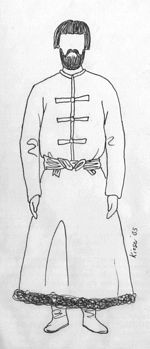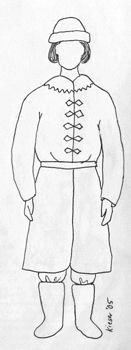
One version of the svita.
Another version of the svita (shuba?).
As the word "shuba" is of eastern origin, perhaps it gradually came to be applied to the garment known as kozhukh after the Mongol conquest, which is why Rabinovich only mentions the kozhukh for early period, and by later period discusses both terms and the confusion between them. It is entirely possible that the terminology spread unevenly in different regions of Rus, adding to the confusion.
Kozhukh:
-
For the 9th-13th cent., the most widespread winter upper garment was the kozhukh [кожух]. It’s very name says that it was made of skins of animal with the fur inside. The common people wore the kozhukha with the “naked” sheepskin, as it would later become called, tulupy [тулупы] or (more short garment) polushubki [полушубки], also made mainly of sheepskin. The rich and the elites sewed expensive kozhukhi, covered with gold Byzantine material, edged with lace [кружево], and decorated with stones. In 1252, Daniil Galitskij dressed for a meeting with foreigners “kozhukh of olovira Greek and gold lace flat sewn, and boots of green khza sewn with gold” (PSRL, I, stb. 814). Expensive kozhukhi were desired military spoils (SPE, Page eleven). If peasants and ordinary city dwellers wore kozhukhi, to defend from the winter cold, then nobles dressed up with richly decorated for clothing for prestige, possibly, and not for cold weather. (Rabinovich)
In the 13th-17th centuries, the common person wore the kozhukh, that is a naked shuba, with the fur not covered by fabric. Poor people - peasants and city dwellers - as in antiquity, wore sheepskin or, more rarely, goatskin. For prosperous city dwellers and nobles it was made from carefully selected, even expensive, fur. And a princely kozhukh could be sewn with stones and plaques. Ivan Kalita (ruled 1328-1340) had 4 kozhukhy sewn with pearls and plaques, one was described as raspberry or cochineal in color (?). He also had one "kozhukh" covered with yellow moire (which according to the usual definition would actually make it a shuba. 150 years later, a Verejskij prince willed to his son a "kozhukh covered in damask, lined with sable.) (Rabinovich, 13-17th)
Shuba:
-
In ancient Rus, the shuba never had the fur on the outside. The fur was used only for
linings. The outer fabric was as fine cloth as the wearer could afford. Kireyeva calls
this garment “ancient” but only give a detailed description in the section on Muscovite
Rus. (Kireyeva)
Prosperous city dwellers and nobility prefered to cover their fur coats with fabric as valuable as they could afford. Although, as noted above, even great princes apparently wore naked shuby, i.e. kozhukh. Shuby, like kaftans, existed in many styles depending on fashion. This is mostly evident after the 15th century (so I will not discuss the various styles here). The 16th century wardrobe of Prince Obolenskij included 6 shuby - "velvet shuba on sable, damask shuba on sable with 11 carved pomegranate buttons, shuba of naked sable, shuba martin naked, two shuby ermine..." In 1668, a dowry included 5 shuby; "gold satin shuba with lace on ermine, yellow damask shuba on sable, hammered silver lace, gilded silver buttons; shuba on ermine, lace hammered gold, gilded silver buttons; colored taffeta shuba on white back fur..." (Rabinovich, 13-17th)
About the cut of the shuba we have little information. It was open-down-the-front, with wide sleeves narrowing to the hand. There existed also folding/collapsing sleeves (to be pushed up on the forearms). The length of the shuba depended on the style - it could be just a little lower than the knee or long almost to the heel. The collar was fur, in various styles. It was generally a loose garment, but some verions were fitted. Decorations were the same as on other upper garments: loops/buttonholes, buttons, hammered lace (?), fur edging. (Rabinovich, 13-17th)
It seems to have been the most formal garment of prosperous city dwellers and nobility. For poor people, it sufficed to have one simple shuba. Such a shuba was worn by Metropolitan Philip during his exile (1566-1569) and was preserved as a relic. It was long and straight, not widened by gores downward. The sleeves were very wide, narrowing to the hands. There were 30 buttons sewn to the right flap, with loops on the left. It was made of rough homespun black-brown broadcloth, over common brown sheepskin. This sheepskin also made the small laid-down collar. (Rabinovich, 13-17th)
-
The opashen’ was formal/dressy special-occasion clothing of cloak-like type. The opashen' was sewn from smooth woolen cloth (sukno). It could have a satin (atlas) turn-down collar trimmed with river pearls on its edge. Lengthwise along the flap of the opashen’ are sewn sixteen pairs of horizontal loops and buttons. Buttons were cast of brass, pear-shaped. Sleeves were long (as long as the hem!) and narrow, with holes in the sleeves near the armholes through which the hands could pass. Owing to sewn in armhole gussets (lastovitsy), opashen' is convenient to wear over-the-shoulders - "on opash' ". In miniatures of the Radzivillovskoj annals, opashni are worn and clasped with buttons, passing hands through the holes in the sleeves. (Bykov/Kuzmin)
Comments and suggestions to lkies@jumpgate.net.
Back to Men's Clothing or Early Rus Clothing.
Back to Russian Material

